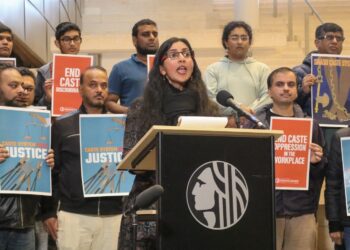In a significant development, the Swaminarayan Akshardham, claimed as the largest Hindu temple outside Asia, is set to welcome the public in New Jersey on October 18. This monumental temple, surpassing the size of both the Bridgewater Lord Venkateshwara temple and the Pittsburgh temple of the same name in New Jersey, was officially inaugurated on October 8.
Nestled on a sprawling 185-acre expanse in Robbinsville county, New Jersey, this architectural marvel was constructed by a dedicated workforce comprising 12,500 volunteers from various corners of the globe. The temple, a project in the making since 2011, gained widespread attention a decade later, although initially for contentious reasons, according to media reports.
Built using an astounding 2 million cubic feet of stone, the Swaminarayan Akshardham temple boasts a fusion of cultures, incorporating materials sourced globally. Notably, the temple’s walls pay homage to American history, featuring intricate carvings of prominent figures like Martin Luther King Jr. and Abraham Lincoln.
Representatives from the Bochasanwasi Shri Akshar Purushottam Swaminarayan Sanstha (BAPS), commonly known as BAPS, revealed that the temple is a testament to unity, welcoming individuals of all genders, castes, and social backgrounds to partake in communal activities such as eating, praying, and serving together.
However, this grand achievement did not come without its share of controversies. The temple’s construction spurred a labour lawsuit, currently on hold, raising concerns about the fine line between religious service and potential labour exploitation.
Yogi Trivedi, a temple volunteer and a religion scholar at Columbia University, marvelled at the temple’s transformative impact, likening the experience to being transported to India despite being in central New Jersey.
Trivedi expressed optimism about the temple becoming a popular pilgrimage destination for Hindus worldwide, describing it as a manifestation of the American Dream, blending sacred Indian heritage with the diverse tapestry of cultures found in the United States.
To endure the frigid winters of New Jersey, ranging from -5 °C to -20 °C, the exterior of the temple has been crafted using unconventional Bulgarian limestone. Inside, the temple showcases an array of stones imported from various corners of the globe, including Greece, Italy, and India.
A distinctive touch within the temple’s premises is the presence of a traditional Indian step well, containing waters from 300 sacred rivers in India and all 50 states of the US union. This symbolic amalgamation of waters stands as a testament to the temple’s inclusive ethos, bridging cultures and traditions.
Remarkably, women played active and pivotal roles in overseeing the project, a rarity in traditional temple construction. Yogi Trivedi, an academician and temple volunteer, highlighted the significance of this diversity, emphasising how it breaks down barriers within the local American community. He envisioned the temple’s design as a reflection of the diverse community it aims to foster, showcasing inclusivity on its very walls.
The construction of Akshardham involved the efforts of 12,500 volunteers from across the globe and had been underway since 2011. However, it gained widespread attention in the United States media around 2021 when a group of immigrant labourers filed a lawsuit against the global temple faith organisation. The lawsuit alleged appalling conditions, including forced labour, excessively long work hours, inhospitable living conditions, and caste discrimination.
According to the initial complaint, the workers were paid a mere $450 per month for their arduous labour, translating to an hourly pay rate of approximately $1.20. Many of these labourers, who arrived in New Jersey from India on religious visas, were Dalits, historically marginalised groups in South Asia’s caste system. The lawsuit claimed that the temple leadership enforced this caste hierarchy within the workplace, as reported by NBC.
Although the lawsuit has been temporarily suspended, with 12 of the original 21 plaintiffs seeking to dismiss their claims, representatives from BAPS Akshardham have assured the public that the temple will be open to individuals of all beliefs and castes. This assurance comes amid widespread coverage in the US media, including a report by Sakshi Venkatraman for NBC, emphasising the temple’s commitment to inclusivity and unity.
A representative from BAPS, as quoted in the NBC report, clarified the distinction between employment and religious volunteer service, known as “seva”. According to the spokesperson, the artisans involved in constructing the temple volunteered their services, emphasising that they were not employees.
Ronak Patel, the spokesperson, asserted in a statement, “The artisans who helped build our mandir came to the US as volunteers, not as employees. We took care of the artisans’ needs in the US, including travel, lodging, food, medical care, and internet and prepaid phone cards, so they could stay in touch with their families in India. BAPS India also supported the artisans’ families in India, so they did not suffer financial hardship as a result of the artisans’ seva in the US.”
However, these assertions have not silenced the concerns raised by activists, who argue that the allegations still highlight the delicate boundary between “religious service and work exploitation.” This issue is particularly pertinent for vulnerable communities like the Dalits.
Viswanath, a co-founder of the civil rights group Hindus for Human Rights, expressed his reservations, stating, “A place of worship, a temple, is such an important space, especially for an immigrant community who’s making home in a new country. I would want anybody who goes to the temple to really ask themselves, really do some soul-searching, about going to a temple where there are such serious allegations of labour and human rights violations.”











